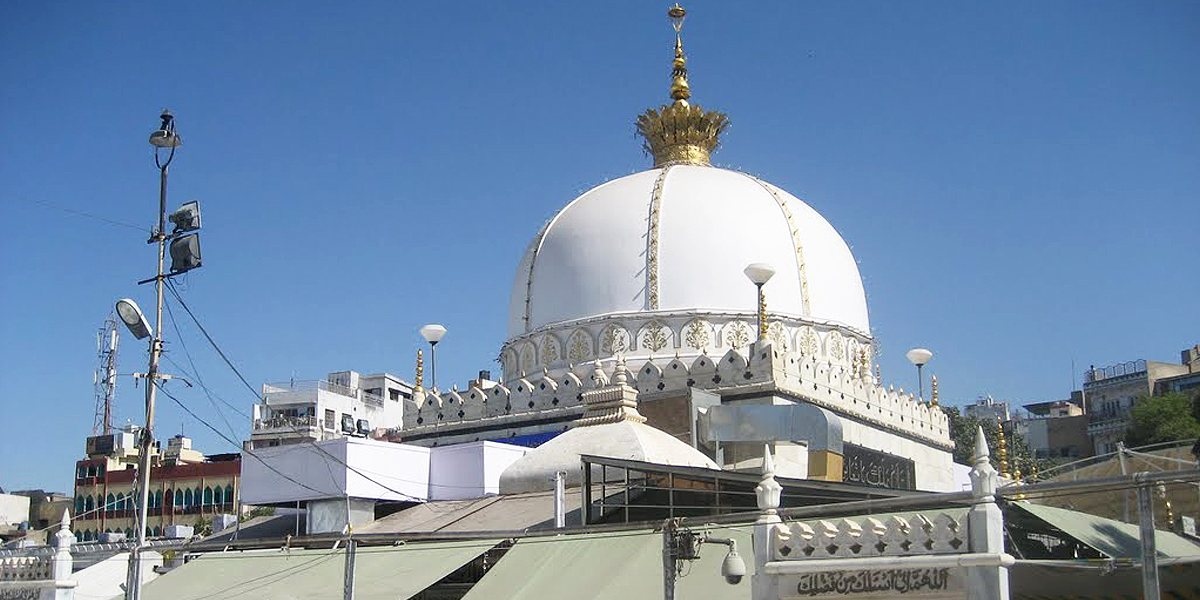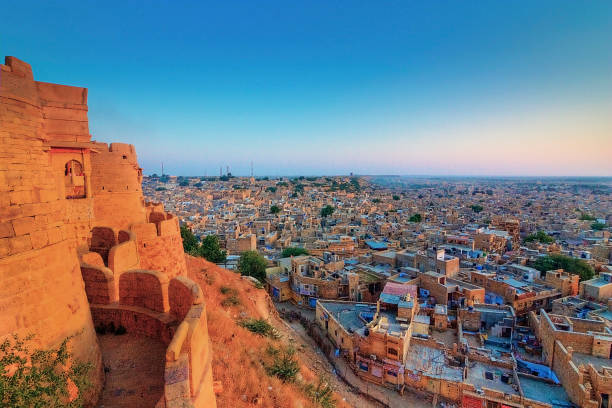Ajmer is bustling city, located 130 km southwest of Jaipur and just 14 km from the pilgrimage town of Pushkar. The city of Ajmer gets its name from “Ajay Meru”, which can be roughly translated as “invincible hill”. Home to a number of tourist places, Ajmer can be a perfect representation of the diversity of the Indian culture and ethics, and displays a perfect blend of religion, community, culture, etc., coexisting and flourishing in harmony.
Pushkar is a small temple town located around 14 km from Ajmer. Every November, Pushkar is host to the Pushkar Mela, one of the biggest Camel Fairs in the country.
WEATHER
TRAVEL SEASONS |
MIN/MAX TEMPERATURE |
SEASON |
October- March |
21°C - 32°C |
Pleasant weather |
July-September |
26°C - 35°C |
Monsoon Season |
April-June |
34°C - 44°C |
Summer Season - Quite Hot |
AVERAGE MONTHLY RAINFALL |
Month |
Jan |
Feb |
Mar |
Apr |
May |
Jun |
Jul |
Aug |
Sep |
Oct |
Nov |
Dec |
Rainfall (mm) |
5.0 |
6.5 |
5.0 |
6.8 |
11.3 |
39.0 |
119.2 |
119.6 |
49.2 |
11.9 |
2.4 |
2.5 |
BEST TIME TO VISIT
October to March which comprises the Monsoons and winter season is the best time to visit Ajmer. The weather is pleasant unlike the scorching heat of summer during April and June. Hence, summer is a big no unless you're planning to visit during the Ur months, plan your visit in May. The city is lush green and refreshing during Monsoons with picturesque surroundings. Most festivals, both religious and cultural takes place during October and November with the beautiful weather as a cherry on top, making it an ideal time to visit Ajmer.
CUISINE
Ajmer's cuisine derives much of its spice, excitement and colour from the street food here. The must haves here are the Chaat, Samosa, Kadi-Kachori, Kadi-Bhujje, Sai Bhaji and Koki. These are popular and widespread in Ajmer's street and can be the most enjoyable. Other than these, Ajmer has a number of restaurants which offer various vegetarian and non-vegetarian options. Sweet Sohan Halwa is also very famous and you should try it if you ever go there!
Pushkar is a tiny town but full of little surprises in its cuisine. It has restaurants which can offer you a number of cuisines from Italian to Chinese. It only gets better as local, popular and exquisite preparations are available at pretty low prices. The standouts of the food here are Malpua, Poha, Dal Chaat, Dal Bati Choorma and Lassi are the must-haves in Pushkar. However since Pushkar is a temple town full of religious activity and festivity, meat and alcohol are strictly prohibited.
Halwai-Ki-Gali is one of the famous streets of Pushkar where you will get different types of Indian snacks. One can also enjoy here proper Rajasthani styled food as there are so many Dhabas offering the same especially Dal-Batti and Churma, one of the famous foods of Rajasthan.
SHOPPING
The vibrant city of Ajmer offers you an amalgam of colorful artifacts, ethnic clothing, Rajasthani handicraft, and much more. Some of the things that are famous in Ajmer are colorful turbans, tableware, perfumes, Jodhpuri joothis, bandhej sarees, brassware, silver ornaments, benzoin resin, leather articles, etc. Listed below are some of the famous markets of Ajmer: Dargah Bazaar, Urban Haat Bazaar, Chudi Bazaar, Naya Bazaar, Mahila Mandi, Nala Bazaar, Madar Gate
You would love to stroll around the little vibrant Pushkar market, which is not more than a kilometre of local shops, showrooms and emporiums that start near the lake and end at the Mela ground. Keep at least a day exclusively for shopping in Pushkar as there is a huge variety of products available at reasonable prices. Be it items like embroidered clothes, silver jewellery, groovy accessories, rose products and leather goods or decorative pieces like miniature paintings, colourful puppets and wall hangings, the market has it all. The main shopping area is Sadar Bazaar but there are shops all across Sarafa Bazaar, Baza Bazaar and Kedalganj Bazaar.
LANGUAGE
Basically, the people of Ajmer and Pushkar make use of Hindi and Rajasthani for mutual conversation. You will also see perfect use of English by many people as lots of foreigners are found in holy town of Pushkar.
THINGS TO DO
1. VISIT THE AJMER SHARIF DARGAH
Built in honour of Khwaja Moin-ud-din Chishti, a notable Sufi saint from Persia, the Ajmer Dargah is one of the most revered Muslim shrines and known to welcome people of all faiths and religions. During the ‘Urs’ Festival celebrated on the death anniversary of the saint, the Dargah is decorated beautifully, with twinkly lights and lanterns. The festival lasts for about 6 days which includes overnight qawwali performances. An added incentive is the delicious food that is offered to all attendees.
2. CAMPING WITH A TWIST
Camp in Pushkar, a small town a few kilometers away from Ajmer. Rajasthan, being a land of Maharajas, even a stay in the tents here is a lavish and comfortable affair. The campers here are entertained with folk music and dance performances around a bonfire, offered scrumptious food and drinks. Definitely one of the best things to do while in Ajmer.
3. VISIT THE GOVERNMENT MUSEUM
This museum is situated within the ancient Mughal emperor Akbar’s Palace. After the Mughals, the British took over Ajmer, and they used this place as their arsenal in 1857, resulting in this place’s other name, ‘Magazine’. Tourists can still see many old weapons, armours, currencies from different eras, and a variety of inscriptions, sculptures and paintings of past Rulers.
4. BOATING IN ANA SAGAR LAKE
Ana Sagar Lake is one of the most popular tourist places in Ajmer. The lake offers a breathtaking view of the city and has a vibe that will make you feel at peace. You can just sit by the banks of the lake and admire its regal beauty.
However, we recommend you try boating here that spans the entire lake and gives you a glimpse of the city’s scenic beauty. This way you get to explore the entirety of the lake and soak in every beautiful moment.
5. EXPLORE THE PUSHKAR MELA
India's greatest tribal gathering, Pushkar Mela is held annually in November from Karthik Ekadashi to Karthik Purnima as per the Hindu calendar. It is a grand travel experience held on a vast scale. People visit the fair to witness the beauty of Rajasthani Culture. Attracting more than 400,000 tourists, funky competitions like 'Matka Tod', 'Longest Moustache', and 'Bridal Competitions', are held during the annual Pushkar Fair. Spread over five days, more than 11,000 cattle, horses and camels are part of this visual spectacle.
6. AN EXCITING CAMEL SAFARI
Taking a camel safari and exploring the dune is not only one of the most exciting things to do in Pushkar desert, but also among the most exciting things to do in Rajasthan. Camel safari, Pushkar takes you on a bumpy ride through the arid topography and desert hamlets. The camels travel up to the dunes, where the guests can witness a stunning sunset over the dunes. From overnight camel safari to sunset/sunrise camel safari, there’s so much you can try in this little town.
7. HOT AIR BALLOON RIDE IN PUSHKAR
If you are in Pushkar around the fair you must take a balloon ride. This gives you an opportunity to avoid the crowds and at the same time experience the fair. Glide gently above the crowd over the vast expanse of the dunes to get an amazing bird’s eye view of the fair and the desert. Drift over the lake and the temples of this ancient sacred town and feel the magic of floating over this motley humanity.
8. TAKE A HOLY DIP IN PUSHKAR LAKE
The sacred lake of the Hindus, Pushkar Lake is one of the popular pilgrimage sites in the country. You can find more than 52 ghats and 400 temples surrounding the lake. Thousands of devotees take a holy dip in the lake every year. You can also be a part of several religious ceremonies held at these ghats. Some of the well known ghats include Brahma Ghat, Varaha Ghat, Gau Ghat, Badri Ghat, and Gangaur Ghat.
9. JEEP SAFARI IN PUSHKAR
Travellers with a penchant for adventure must try jeep safaris. Jeep safari takes you through the rugged paths to explore offbeat destinations of Rajasthan. Not only will you drive through barren desert landscape but you will also get an opportunity to explore the hidden charisma of some of India's most remote and colourful villages, ruins of magnificent forts and palaces, ancient temples and rare wildlife. A refreshing dip in the local waterfall hidden in the trees refreshes you thoroughly after a tiring trail of approximately five to six hours.
10. SPEND A DAZZLING EVENING AT PUSHKAR LAKE
Evenings at Pushkar are best spent sipping hot coffee by the lake side. Watch the day bidding adieu and a beautiful evening taking over. As the golden sun dips behind temples, the lake’s water mirrors the changing hues of the sky from blue to orange and then red and slowly black takes over transforming the day into a beautiful night.
Spend some quiet hours sitting on the stairs of the lake listening to the music coming from all directions - hymns and bells from the temple, nagara beats from the ghat, gentle strumming of a guitar from some cafe and the sound of Ravanhatha being played by some bhopa musician sitting just next to you.
PLACES TO VISIT IN AJMER
1. THE AJMER SHARIF DARGAH
This is a Sufi shrine which encloses the ‘maqbara’ (grave) of Garib Nawaz, the Sufi saint Khwaja Moinuddin Chisti. Built in the 13th century, the shrine is popular among people of all faiths who flock here to have their prayers answered. The shrine has three gates – the main gate or the Nizam gate, the Shah Jahan gate erected by the Mughal Emperor and the Buland Darwaza. Another big draw at this holy shrine is the sacred and scrumptious food that is served to devotees. Cooked in giant cauldrons known as ‘degs’, devotees gather in throngs to be blessed by this prasad.
2. ADHAI DIN KA JHONPDA
The Adhai Din Ka Jhonpda was originally built to function as a Sanskrit college but was later converted into a mosque by Sultan Ghori in 1198 AD. An impressive blend of Indo-Islamic architecture, the structure was further beautified by Sultan Iltutmish in 1213 AD. Legend has it that the mosque is known as Adhai din ka Jhonpda (literally meaning, The Hut of Two and a Half Days) because of a two and half day fair held here during Urs in the 18th century.
3. ANASAGAR LAKE
Anasagar Lake is a scenic artificial lake, commissioned and built by Arnoraj Chauhan, son of Ajaypal Chauhan, between 1135 and 1150 AD. Arnoraj was also known as Anaji, which gives the lake its name. Many years later, Mughal Emperor Jahangir added his touch to the lake by laying out the Daulat Bagh Gardens near the lake. Emperor Shah Jahan too, contributed to the expansion by building five pavilions, known as the Baradari, between the garden and the lake.
4. LAKE FOY SAGAR
A beautiful artificial lake that appears flat, Lake Foy Sagar was built by an English engineer, Mr. Foy in 1892 AD. Interestingly, this work was taken up to provide famine relief through wage employment to locals. Lake Foy Sagar offers a beautiful view of the Aravali range.
5. SONIJI KI NASIYAN
Soniji ki Nasiyan, also known as the Ajmer Jain Temple, is a wonderful example of ornate architecture, and is dedicated to Risabh or Adinath. Its entrance is made of red stone and the marble staircase inside is engraved with images of the holy Tirthankars – omniscient teachers of Jain faith who taught righteousness. Constructed in the late 19th century, this temple is counted among the richest temples in India. Its main chamber, Swarna Nagari (City of Gold), is aptly named so because of the several gold-plated wooden figures it houses within its walls.
6. GATEWAY OF TARAGARH FORT
Gateway of Taragarh Fort is the imposing main gate of Taragarh fort which is built on a crest of a hill. The main gateway of the Taragarh, which consists of two colossal bastions on both sides with strong guard rooms, has sculptures of elephants adorning it. The main highlights of this once magnificent fort are its water reservoirs and the Bhim Burj, on which the canon called Garbh Gunjam (Thunder from the Womb), was mounted. There is also the magnificent Rani Mahal with its stained windows and murals, which used to house the wives of the rulers. All this makes the Taragarh Fort a nonpareil example of Rajaputana architecture that’s also a major attraction for tourists visiting Ajmer.
PLACES TO VISIT IN PUSHKAR
1. BRAHMA TEMPLE
Nestled in the picturesque Pushkar valley beyond the Nangaparvat and Anasagar Lake, the Brahma temple holds a special place in the hearts of Indians. It is the only temple in the world dedicated to Lord Brahma. Built with marble and decorated with silver coins, this temple can be identified by its red spire and the image of a swan (considered sacred to Lord Brahma). The chaturmukhi (four faced) idol of Lord Brahma is housed in the inner sanctum. A marble statue of the sun god stands sentinel at the temple. Interestingly, while all the gods are shown bare footed, Surya is shown wearing ancient warrior’s boots.
2. PUSHKAR LAKE
According to Hindu scriptures, the sacred Pushkar Lake is described as ‘Tirtha Raj’, the king of all pilgrimage sites. No pilgrimage is considered to be complete without a dip in the holy Pushkar Lake. Semi-circular in shape and about 8-10 metres deep, Pushkar Lake is surrounded by 52 bathing ghats and over 400 temples and is truly a magnificent sight to behold.
3. VARAHA TEMPLE
Varaha temple is the largest and the most ancient temple of Pushkar. Constructed by the 12th century ruler, King Anaji Chauhan, this temple is dedicated to the third incarnation of Lord Vishnu as a wild boar. Legend has it that Varaha rescued the earth from depth of the primeval water, where it was dragged down by a demon (Hirnayaksh). It is one of the most visited temples in Pushkar.
4. SAVITRI TEMPLE
Dedicated to Lord Brahma's first wife, Goddess Savitri, this temple is situated on a hillock right behind the Brahma temple. While climbing the long series of steps leading to the temple, one can catch a panoramic view of the lake, surrounding temples and sand dunes. The presence of the only Brahma Temple in Pushkar is the outcome of Savitri’s curse to Brahma for marrying another Goddess, Gayatri, while starting his yagna in Pushkar.
5. MAN MAHAL
Built as the royal residence of Man Singh, Man Mahal is a stunning work of architecture. From the top of the grand palace, one can get a splendid view of the surroundings. The reflection of the temples in Pushkar in the Pushkar Lake is a mesmerising sight rendering it a perfect site for photography.
6. GURUDWARA SINGH SABHA
Gurudwara Singh Sabha, situated in the eastern part of Pushkar, was built in the beginning of the 19th century to commemorate the visits of the first and the tenth gurus- Guru Nanak Dev and Guru Govind Singhji.
7. RANGJI TEMPLE
The gracious and conspicuous Rangji Temple is another popular shrine that witnesses thousands of pilgrims and tourists every year. The temple is dedicated to Lord Rangji, believed to be an incarnation of Lord Vishnu. The influence of South Indian style, Rajput style and Mughal style in the temple’s architecture is highly noticeable.


